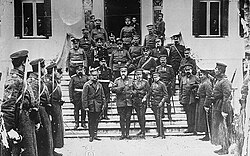
Back Russies-Japannese Oorlog Afrikaans Guerra ruso-chaponesa AN الحرب الروسية اليابانية Arabic Guerra ruso-xaponesa AST Rus-yapon müharibəsi Azerbaijani روس-ژاپون ساواشی AZB Рус-япон һуғышы Bashkir Руска-японская вайна Byelorussian Руско-японска война Bulgarian রুশ–জাপান যুদ্ধ Bengali/Bangla
| Russo-Japanese War | |||||||||
|---|---|---|---|---|---|---|---|---|---|
 Clockwise from top: Russian cruiser Pallada under fire at Port Arthur, Russian cavalry at Mukden, Russian cruiser Varyag and gunboat Korietz at Chemulpo Bay, Japanese dead at Port Arthur, Japanese infantry crossing the Yalu River | |||||||||
| |||||||||
| Belligerents | |||||||||
| Commanders and leaders | |||||||||
| Strength | |||||||||
|
1,365,000 (total)[1]
|
1,200,000 (total)[1]
| ||||||||
| Casualties and losses | |||||||||
|
Total: 43,300–71,453 dead[3][4]
Material losses:
|
Total: 80,378–86,100 dead[3][4]
Material losses:
| ||||||||
| Events leading to World War I |
|---|
 |
|
The Russo-Japanese War (8 February 1904 – 5 September 1905) was fought between the Russian Empire and the Empire of Japan over rival imperial ambitions in Manchuria and the Korean Empire. The major land battles of the war were fought on the Liaodong Peninsula and near Mukden in Southern Manchuria, with naval battles taking place in the Yellow Sea and the Sea of Japan.
Russia had pursued an expansionist policy in Siberia and the Far East since the reign of Ivan the Terrible in the 16th century.[5] At the end of the First Sino-Japanese War, the Treaty of Shimonoseki of 1895 had ceded the Liaodong Peninsula and Port Arthur to Japan before the Triple Intervention, in which Russia, Germany, and France convinced Japan to relinquish its claim. Japan feared that Russia would impede its plans to establish a sphere of influence in mainland Asia, especially as Russia built the Trans-Siberian Railroad, began making inroads in Korea, and acquired a lease of the Liaodong Peninsula and Port Arthur from China in 1898. Japan signed the Anglo-Japanese Alliance in 1902, and began offering to recognize Russia's dominance in Manchuria in exchange for recognition of Korea as part of Japan's sphere of influence. However, this was rejected by Russia.
After negotiations broke down, Japan opened hostilities in a surprise attack on the Russian Pacific Fleet at Port Arthur on 9 February [O.S. 27 January] 1904. Both sides declared war, and Japanese troops landed in Korea, crossed the Yalu River into Manchuria in May, and landed more forces on the Liaodong Peninsula. In August, the Japanese laid siege to Port Arthur, which eventually fell in January 1905. In March 1905, Japanese troops took Mukden, the Manchurian capital, after heavy fighting. The Russian Baltic Fleet, which had sailed over seven months and 18,000 nautical miles (33,000 km) from the Baltic Sea, arrived in the region in May and was intercepted and destroyed by the Japanese Combined Fleet at the Battle of Tsushima. The war was concluded with the Treaty of Portsmouth (5 September [O.S. 23 August] 1905), mediated by US President Theodore Roosevelt.
The treaty recognized Japanese interests in Korea, and awarded to Japan Russia's lease on the Liaodong Peninsula, control of the Russian-built South Manchuria Railway, and the southern half of the island of Sakhalin (Karafuto). The complete military victory of an Asian and non-Western nation over a European and Western power surprised international observers, and transformed the global balance of power, with the Empire of Japan emerging as a great power and the Russian Empire declining in prestige among the European powers. Russia's incurrence of substantial casualties and losses for a cause which resulted in a humiliating defeat contributed to internal unrest culminating in the 1905 Russian Revolution, during which the tsarist autocracy was forced to make concessions.
- ^ a b Mitchell, T. J.; Smith, G. M. (1931). Casualties and Medical Statistics of the Great War. London: Her Majesty's Stationery Office. p. 6. OCLC 14739880.
- ^ Reese 2019, p. 197.
- ^ a b Dumas, S.; Vedel-Petersen, K.O. (1923). Losses of Life Caused By War. Oxford: Clarendon Press. pp. 57–59.
- ^ a b Matthew White. "Mid-Range Wars and Atrocities of the Twentieth Century – Russo-Japanese War". Historical Atlas of the Twentieth Century. Archived from the original on 10 September 2017. Retrieved 17 October 2013.
- ^ Steinberg 2008, p. 2.